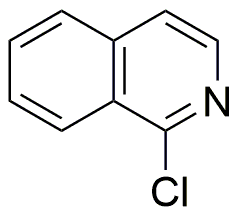1-Chloroisoquinoline is widely utilized in research focused on:
- Synthetic Organic Chemistry: It serves as a key intermediate in the synthesis of various complex organic compounds, enabling researchers to develop new pharmaceuticals and agrochemicals.
- Pharmaceutical Development: This compound is explored for its potential in drug discovery, particularly in the development of anti-cancer and anti-inflammatory agents, due to its unique structural properties.
- Material Science: It is used in creating specialized polymers and coatings, enhancing material properties such as durability and resistance to environmental factors.
- Biochemical Research: Researchers utilize it to study enzyme interactions and metabolic pathways, providing insights into biological processes and potential therapeutic targets.
- Fluorescent Probes: 1-Chloroisoquinoline is employed in the design of fluorescent probes for imaging applications, aiding in biological research and diagnostics.
General Information
Properties
Safety and Regulations
Applications
1-Chloroisoquinoline is widely utilized in research focused on:
- Synthetic Organic Chemistry: It serves as a key intermediate in the synthesis of various complex organic compounds, enabling researchers to develop new pharmaceuticals and agrochemicals.
- Pharmaceutical Development: This compound is explored for its potential in drug discovery, particularly in the development of anti-cancer and anti-inflammatory agents, due to its unique structural properties.
- Material Science: It is used in creating specialized polymers and coatings, enhancing material properties such as durability and resistance to environmental factors.
- Biochemical Research: Researchers utilize it to study enzyme interactions and metabolic pathways, providing insights into biological processes and potential therapeutic targets.
- Fluorescent Probes: 1-Chloroisoquinoline is employed in the design of fluorescent probes for imaging applications, aiding in biological research and diagnostics.
Documents
Safety Data Sheets (SDS)
The SDS provides comprehensive safety information on handling, storage, and disposal of the product.
Product Specification (PS)
The PS provides a comprehensive breakdown of the product’s properties, including chemical composition, physical state, purity, and storage requirements. It also details acceptable quality ranges and the product's intended applications.
Certificates of Analysis (COA)
Search for Certificates of Analysis (COA) by entering the products Lot Number. Lot and Batch Numbers can be found on a product’s label following the words ‘Lot’ or ‘Batch’.
*Catalog Number
*Lot Number
Certificates Of Origin (COO)
This COO confirms the country where the product was manufactured, and also details the materials and components used in it and whether it is derived from natural, synthetic, or other specific sources. This certificate may be required for customs, trade, and regulatory compliance.
*Catalog Number
*Lot Number
Safety Data Sheets (SDS)
The SDS provides comprehensive safety information on handling, storage, and disposal of the product.
DownloadProduct Specification (PS)
The PS provides a comprehensive breakdown of the product’s properties, including chemical composition, physical state, purity, and storage requirements. It also details acceptable quality ranges and the product's intended applications.
DownloadCertificates of Analysis (COA)
Search for Certificates of Analysis (COA) by entering the products Lot Number. Lot and Batch Numbers can be found on a product’s label following the words ‘Lot’ or ‘Batch’.
*Catalog Number
*Lot Number
Certificates Of Origin (COO)
This COO confirms the country where the product was manufactured, and also details the materials and components used in it and whether it is derived from natural, synthetic, or other specific sources. This certificate may be required for customs, trade, and regulatory compliance.


